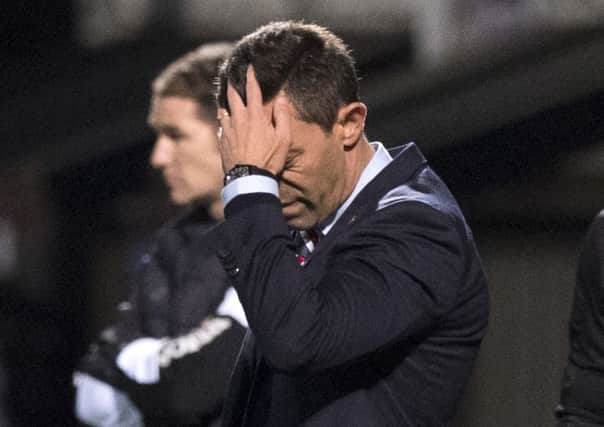Five reasons for Rangers' continued struggles in defence


Conceding a high percentage of shots on goal
Rangers have faced 11 shots on target in the Ladbrokes Premiership and have conceded eight goals.


Tempting though it may be, it’s too easy to blame goalkeeper Wes Foderingham. With the exception of Simon Murray’s strike at Ibrox, and perhaps Ben Heneghan’s opening day header where Foderingham never came for the cross, it’s hard to look at any other concession and argue he was genuinely at fault. Even in the two examples given you could make a case the other way.
Advertisement
Hide AdAdvertisement
Hide AdThe finishing of Rangers’ opponents has been of a strong standard so far. The Ibrox side are sixth in the league in goals conceded, but third in expected goals conceded, according to the advanced statisticians. Therefore, there’s a small element of luck going against them, but if they want to be challenging Celtic at the top of the table, then the latter statistic needs to be stronger than it is currently, as Rangers’ numbers have more in common with Motherwell than they do Aberdeen or their arch-rivals.
Lack of protection due to system
Rangers play an old fashioned 4-4-2 formation. It’s got two strikers and two wingers, no centre-midfielder adding balance to the wing, and no playmaker masquerading as a second striker. Add this to the freedom granted to both full-backs to get forward and support the attack, and you have a recipe for the centre-backs to become isolated.


For Hibs’ equaliser in the 3-2 victory at Ibrox, when the visitors win the ball back about 20 yards from their own goal there are eight Rangers players in the opposing half (Picture One, above). This wasn’t a set-piece or even an attack that got anywhere close to the Hibs’ byline. Yet, all it took was for John McGinn to curl the ball into the space vacated by James Tavernier for Murray to run on to, and Hibs were off and running in a two-on-two scenario.
The goal conceded at Ross County was another example of Rangers being caught too high up the park on a routine attack. Niko Kranjcar was dispossessed around 10 yards past halfway, with Michael Gardyne quickly feeding play down the right, where Lee Wallace would have been if he wasn’t so far advanced.
Having attack-minded full-backs is not something uncommon in football, but they’re usually in a system designed to cover for it. With Ryan Jack and Graham Dorrans, Rangers’ midfield two, expected to do so much more than just protect the back-line, this is not always possible.


Organisation and communication
There are a lot of new pieces in this Rangers team and, in defence at least, it could be a case that they’ve just to come to an understanding with each other.
Last Friday’s game against Partick Thistle provided a perfect example with Jack telling Bruno Alves to cover his man, only for Alves to step up in a vain hope to play offside, which eventually led to Thistle going in front through Chris Erskine.
It’s not the only instance of this type of thing happening. At Vykintas Slivka’s goal, which eventual proved to be the match winner, the Hibernian midfielder was alone 25 yards from goal. This was because Kenny Miller had left his man to cover the possibility of a two-on-one from a Hibs’ throw-in when Alfredo Morelos was slow to react to his team-mate’s instructions. It was only once the throw-in was taken did someone react, with Dorrans sprinting out from the defensive line, by which point it was too late and the Lithuanian found the back of the net with a driven shot from distance.


Advertisement
Hide AdAdvertisement
Hide AdThis has been an issue since the opening league match of the season. Though a great cross, which Foderingham perhaps should have collected, there was plenty wrong with Motherwell’s goal from a Rangers point of view. Josh Windass and Lee Wallace were in position to close down the initial taking of the free-kick as it was played short by Richard Tait, but both had turned their back on the play, allowing Craig Tanner to whip in the cross. Looking at the action in the centre, it’s clear that few were certain who they were supposed to be marking, with Alves and Fabio Cardoso both leaving their initial man to cover the one in front.
James Tavernier’s back post covering
The full-back’s strengths and weaknesses are well known. A threat going forward, he’s prone to lapses in concentration in defence, especially when he’s covering the back post. The system doesn’t do him any favours in this regard as he’s often posted missing because he’s still up the other end, but he’s still weak defensively when he gets back into position.
The goal at Ross County and Thistle’s second last Friday were perfect examples. In both instances, Tavernier identified who he should be covering and then just... didn’t.
Some fans would maybe wish to see the player dropped, but it’s doubtful whether they have enough strength in attack to offset his absence. He’s another who could perhaps benefit from a change in the formation.
Bruno Alves
The Portuguese defender has yet to justify the hype surrounding his transfer. He’s not been terrible, in fact, he’s contributed well to Rangers as an attacking threat, often starting moves which lead to good chances in the opposing penalty area, but he’s not been the answer to their defensive issues so far.
Five, arguably six, of Rangers’ goals conceded in the league so far have been partially down to the centre-back. Whether it was his odd attempt at covering Cardoso and stopping Murray from shooting in the match against Hibs, his jumping sideways in the free-kick wall against Partick Thistle, his gambling on getting to the ball before Murray in the build up to Hibs’ second, or getting beat too easily by Faissal El Bakhtaoui against Dundee, there are plenty of instances showing individual errors from the experienced international.
